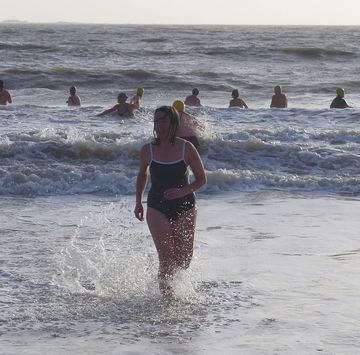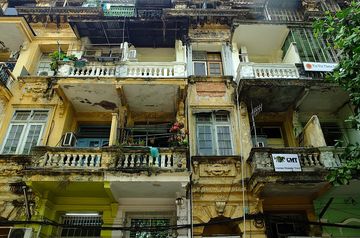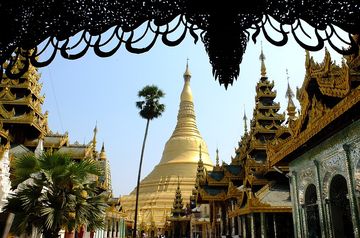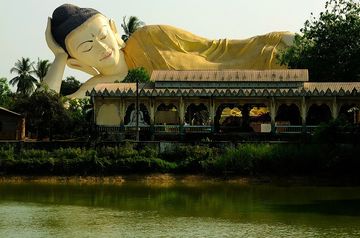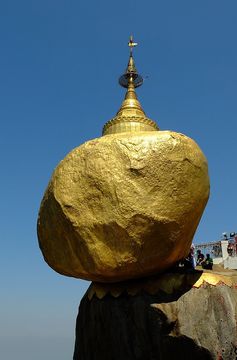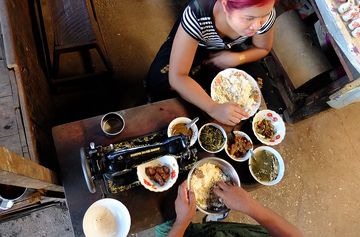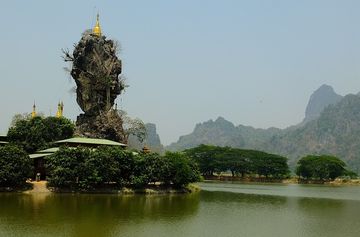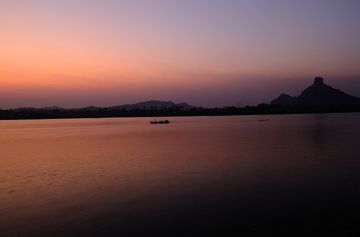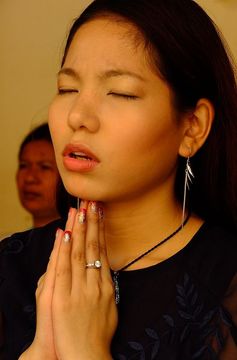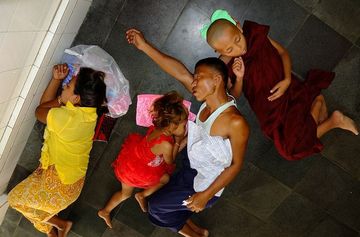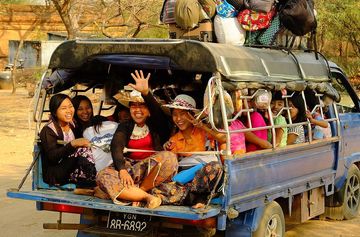Email Updates English
Following is the full text of all English email updates we sent during this trip. The texts are original copies, shown here as sent: typos, errors, warts and all (the same in French).
We've also included the pictures attached to the mails. Clicking a thumbnail will open a bigger version and use the left and right cursor keys to navigate from one picture to the other.
- Mail from 12 Feb 2014: Off to SEA 2014
- Mail from 21 Feb 2014: Muscat, Phnom Penh, Kampot
- Mail from 03 Mar 2014: Preah Vihear, Siem Reap, Angkor
- Mail from 14 Mar 2014: Bangkok, Mandalay
- Mail from 25 Mar 2014: Bagan, Inle Lake, Kalaw (and Yangon)
- Mail from 26 Apr 2014: Yangon, Bago (Golden Rock, Hpa An, Moulmein later)
- Mail from 30 Apr 2014: Golden Rock, Hpa An, Moulmein, Myawaddy
- Mail from 03 May 2014: Kantha Bopha hospitals; Burmese impressions
Subject: Off to SEA 2014
Date: Wed, 12 Feb 2014 10:51:45 +0000
Dear friends, yeah, it's that time of the year again:-) Later today we'll be catching our bus to Heathrow from where we fly to Bangkok, via Muscat. This trip, nicknamed not very inspiredly SEA 2014 (SEA = South East Asia), brings us, for the first time ever, to Burma (Myanmar). We'll stay there for about 4 weeks and will also squeeze in three weeks in Cambodia, one of our favorite countries (believe it or not, there are a few temples in Cambodia we still have not seen, for instance the hilltop site of Preah Vihear (see https://en.wikipedia.org/wiki/Preah_Vihear_Temple ). And of course, we will also pay our respects to the temples of Angkor! In Burma we will concentrate in the main sights (as we always do for a first trip). We fly into Mandalay, will do a few day trips there, then continue to the temples of Bagan (where it'll be interesting to compare them to Angkor). After that, a few days on and around Inle Lake, then Yangoon and finally the long trek south towards Dawai, where we will turn sharp left, for the fleshpots of Thailand. All in all we'll be around two months on the road and as usual we will send reports from the road. For those who want to see more, there's already a Google map with our itinerary and a few words by Vero about our budget planning. See https://trvl2.com/SEA14/blog/Introduction for some links. Last but not least under this address: https://trvl2.com/Nindia13/photos/Photos you'll find a few photo albums about last year's trip to India. The next mail should be in your inbox in a good week from now, probably from Phnom Penh. PS: Vero did indeed do the "Canard Givrés" thing in La Baule, on 22 December 2013. She says it was cold (water temp ~10C) but not as bad as she'd feared. She is really, really happy that she did it and Thomas (who refrained from bathing and took photos instead) has a feeling that this wasn't her last winter swim in La Baule. One photo is attached. See this website for more shots (most are from other people, not from Thomas): http://canards-givres.e-monsite.com/album/bain-du-22-decembre-2013/ -- Follow us on ~ Suivez nous sur https://trvl2.com/=sea14a
Subject: Muscat, Phnom Penh, Kampot
Date: Fri, 21 Feb 2014 10:43:55 +0700
Dear friends, we're now in Phnom Penh and so far... so good. Normally the flights to destination are straightforward... not so this time: the rain that has waterlogged all of Britain for the last months (years?) has followed us to the Thai/Cambodian border. And it did so with a vengeance. Shortly before we were supposed to land in Muscat (remember, this is a DESERT town) there was a "freak" rain storm which put the whole airport and all the runways under water. Our plane was hence turned back to Dubai (sunshine) where we landed and stood on the airfield for roundabout 3hrs, to wait this thing out. The wonders of modern technology: even while we were quarantined in the plane, a few Omani passengers received photos on their smartphones showing the Muscat runways: a truly biblical scene. But finally we got the go ahead and flew on to Muscat where we landed 4hrs late. Luckily our connecting flight to BKK was also stranded, so we just picked it up and presto went to Bangkok. We landed four hours late at 11pm... which meant that our carefully crafted plan to catch a nightbus to the border was dead in the water (literally). So we spent the night in various airport halls until 6am, when we took a mini bus to Trat and another mini bus to the border. And even there... it rained, albeit sporadically. But since crossing the border we suffered no further meteorological mishaps (other than the blazing sun and 34C). We've already collected our Burmese Visa here in PP. The city hasn't changed a lot since last time, the traffic which was really bad last time is no worse, maybe even a little better. What is changing is the cityscape: there are huge building sites everywhere. They even have a project to build an artificial island at the confluence of the Mekong/Tonle Bassac rivers (similar to the Dubai Palm Island project though smaller). We're really asking ourselves who is paying for this building bonanza... but rumour has it that a few projects are already deep in money trouble. Other than that we did the usual things: strolling along the river banks with a cool breeze, wandering through the markets which are, as ever, a great place to see incredible things and smell incredible smells:-) We also visited the original Phnom Penh (Phnom means hill), the National Museum and various wats. Business as usual, you might say. A short detour, while our passports were with the Burmese embassy, brought us to Kampot, a sleepy town on the south coast. This is a haven for expats and you can see why: balmy weather, good food, nice and varied landscapes (many hills with caves, the Bokor highlands and the sea). Perfect for a two-day trip. Tomorrow we'll head to Sra Em, a fleapit near the north border, as a jumping-off point for the Khmer temple of Preah Vihear. More about that in a good week, from the fleshpots of Siem Reap. We are fine so far, no problems with either the weather or the food. All the best Thomas + Vero -- Follow us on ~ Suivez nous sur https://trvl2.com/=sea14a
Subject: Preah Vihear, Siem Reap, Angkor
Date: Mon, 3 Mar 2014 11:33:37 +0700
Dear friends, we are now for a week in Siem Reap, touring the ever fascinating and captivating temples of Angkor. Before that, we went to the far north to visit the out-of-the-way temple of Preah Vihear. This was on our to-do list for a long time, but getting there was really a headache in the "bad"old days. However, in the last years the Cambodian gov has upgraded the roads in this region, not least to lure tourists to this specific temple which, as you may recall, is a matter of armed dispute between Cambodia and Thailand: to bolster their legal case they want to bring in as many tourists as they can. (The Thais are clearly the aggressors in this case.) The temple itself is not that great, compared to some of the Angkorian temples of the same layout and architecture. What's really drawing people is the location on a rocky spur, around 500 vertical metres above the sweltering northern plains of Cambodia. There are two ways to get up there: one with a moto (that's a motorcycle with driver), the second along the old pilgrim way up a processional staircase (these days mostly a modern wooden structure with around 2400 steps). We decided, with some trepidation, to go for the latter -- though it was quite hot. Luckily, much of the way is in the (semi-)shade of a mature forest and there was also a breeze. Indeed, the walk up turned to be a highlight of the whole visit! Along the way there are many army camps (and what a sorry lot these soldiers are: sleeping under torn canvas, with no electricity and extremely basic sanitation). Up the hill, there are trenches, really long ones concreted over: the conflict seems here to stay. The Thai side is literally a stone throw away, the border here runs only a few dozen metres north of the edge of the temple. The north up here is in the process of being homesteaded; there are many fields freshly slashed-and-burned and there lingers an immense cloud of thin smoke over the region. In fact, after two days there all our clothes we put out of their plastic bags smelled very strongly of smoke, as we discovered in smoke-free but polluted Siem Reap. The saddest, almost absurd bit about that was that the whole route to the temple is plastered with signboards with pious exhortations (all in English not in Khmer!) along the lines of "If the forest dies, we die" or "Love your nation, love your trees". A really bad joke... Siem Reap itself hasn't changed a lot, it's still a quite enjoyable and bustling place. In fact, we found the number of tourists, despite this being the shoulder season, to be incredible high. We've never before, even during high season in January, seen so many tourists in Siem Reap. And it shows: the infrastructure around the temples is at the limit, there are now daily lengthy traffic jams at the south entrance to Angkor Thom and the slightest hiccup suffices to create an unruly backlog of buses, cars and moto-remorks (that's a moto with a little open-air cabin trailer attached). We cycle under our own steam (sometimes literally:-) and we can bypass all these queues. However, for many tourists, by far most of them Asians, a good part of their Angkor experience must be depressingly similar to their home commute. <RANT MODE="SEVERE"> Tourist groups are a fact of tourism (especially in Angkor!) and though they have been a thorn in our flesh for many years, we have built some resilience and tolerance towards them. They are, after all, doing what we are doing, albeit in a different fashion. However, Siem Reap 2014 has really, really tested our endurance. The sheer number of groups is unbelievable, overwhelming. There are hundreds and hundreds out there and they all seem to be where we are. But that's not the biggest problem. (Warning: non-PC stuff ahead.) The biggest problem are the Chinese and the South Korean groups. The latter because of their sheer number, sometimes it seems Siem Reap is just a province of South Korea (similar to the Mont St-Michel, this winter, seemed to be a province of Japan). Even the official city map these days is all in Korean! They are everywhere but they tend to be not badly behaved. The Chinese are perhaps not as numerous but boy, they DO make themselves heard and felt. In fact, they shout, cry and bulldoze their way through the temples in a way that is a severe annoyance to other tourists, whether individuals or groups. If this is a harbinger of things to come, Europe's top sites are certainly in for some serious fun (and serious money) in the not-so-far future. Many Chinese, though not all, are noisy and impolite to the point of rudeness, especially when hunting in packs. As to Western groups... not many. Some Germans (they seem to be the only ones with some money left), a couple of Spaniards... that's it. We feel already better now that this is off our chest! </RANT> A note to the use of bicycles: in the old days, this was the medium of choice to investigate the temples, at least for individual travellers. These days, there are hardly any bicycle users left, as most people opt for those moto-remorks. We found two correlations here: a stronger one is between the girth of a person and the probability they'd use a moto-remork. A weaker one is that the younger crowd tends to go the lazy motorised route, whereas many older people (like us, haha) stick to their old habits and cycle. In a word, those who cycle are old and thin:-) Next mail should come from somewhere in Burma... but the internet there is not as reliable as elsewhere in SEA. So we'll have to wait and see. Otherwise, all is well and we enjoy our time in the sun! All the best Thomas + Vero PS: No photos as our camera (a Fuji X10) only supports PTP transfer mode which is simply not practical for Internet cafes. The PCs here, old clunkers, have no card readers and we left our own at home because we didn't realise that direct access would not work... Sorry for that, we'll upload stuff when we can. -- Follow us on ~ Suivez nous sur https://trvl2.com/=sea14a
Subject: Bangkok, Mandalay
Date: Fri, 14 Mar 2014 15:40:27 +0630
Dear friends,
we're now in Mandalay, awaiting our night train (9pm to 5am) to Bagan.
From Siem Reap, we went to Bangkok, where we visited a few of the
bigger wats and generally strolled around. The atmosphere in the city
is quite strange: as you've probably heard, there are
anti/pro-government protest underway for a long time now. The
protesters have build large tent cities all over Bangkok and the
military stands in between, ostensibly only to help in "medical
emergencies".
Although these camps have a music festival feel (there's a lot of
music, BBQing etc) they are surrounded by high walls of barbed wire
and access is controlled. This makes for a weird feeling in the air.
Also, sometimes somebody makes a political speech which we do not
understand but which sounds quite fiery (though nobody seems to
listen). Very strange.
After 3 days of this we flew to Mandalay, uneventful.
This is Burma's 2nd city, but despite the romantic name ("Road to
Mandalay" and all that) it's not a beauty. In fact, it's a rather
ugly, dusty collection of mostly modern buildings, many of them in
Chinese style (ie externally tiled). The pollution is incredible, a
real throwback to, say, Kathmandu 20 years ago or Delhi.
Indeed, the whole country feels as if in a time warp. There's not much
flashing neon around, no flashy supermarket, not many modern cars. But
the main thing are of course the Burmese and to that end, we can say
that this is an extremely friendly country. They smile, share food in
a pickup (cramped local transport in a truck with two rows of seating)
and are very helpful and curious.
What's to see? Well, pagodas, pagodas and then some:-) The pagodas we
had so far seen in Burmese style (mostly in northern Thailand) were of
the wooden type, here there's a mix of the slender wooden pagodas and
more substantial brick buildings with a certain Indian influence. All
the pagodas we've seen here have been very impressive, some amazing
wooden temples with fascinating carvings and also some stylistically
quite unusual brick temples (mostly plastered and painted in white or
blue).
There's also a famous bridge (google for U Bein bridge) in Amarapura
(a daytrip), built around 1850, made completely from teakwood. This is
now nicely weathered but still strong and in daily use.
Sagaing (another daytrip) was also very good, with many pagodas
beautifully placed on a few hills with many interconnecting pathways.
A quiet, relaxing place which we enjoyed enormously.
Thanks to the dust and the heat, the air is very hazy... the famed
views from Mandalay hill and also the Sagaing hills were less
impressive than we thought/hoped. Perhaps soon after the monsoon, this
is better but for now it's really not the time for nice panoramic
views.
It's early days about our general impressions about Burma but here are
already two observations:
1. This is a very strongly Buddhist country. In that, and also in the
general laid-backness, Burma reminded us a little of Laos.
2. On the other hand, there are some interesting influences from
India. For instance, betel-nut chewing: everybody does it, men, women,
young, old, and even monks! (Many more people chew here than in
India... but for whatever reason, there are not many red stains on the
roads and floors of buildings, contrary to India).
Internet is EXTREMELY, painfully slow, we are typing this in Notepad
because Google is unusable (uploading photos is unthinkable).
Well, other than that everything is fine. The weather is fine, it's
perhaps a degree or two warmer here than in Siem Reap but it's much
drier, so quite OK.
One very good thing about Burma is the street food: very cheap and
filling and also tasty.
The next mail should arrive in a good week from Yangon where the
internet is hopefully a little faster.
All the best
Thomas + Vero
--
Follow us on ~ Suivez nous sur https://trvl2.com/=sea14a
Subject: Bagan, Inle Lake, Kalaw (and Yangon)
Date: Tue, 25 Mar 2014 15:43:22 +0630
Dear friends, with a little delay, here's the next mail. Main reason for the delay is that we decided, after Inle Lake, to spend three more days near the lake, in the mountains around Kalaw. So we only arrived in Yangon this morning, after a (for a change) quite enjoyable night bus ride (we're getting the hang of it). OK, so from Mandalay we took a night train (ordinary class, just for the fun of it) to Bagan. The train was not too bad, after all the anecdotes we'd heard about Myanmar Railways we expected worse. It was VERY shaky and VERY bumpy indeed, but it was on time and not nearly as overcrowded as a comparable Indian train would be. Having said that, Myanmar trains feel a little antiquated and weird, hard to explain that more precisely. Let's just say that if Fawlty Towers were not a hotel but a railway operation, we think it might feel like Myanmar Railways (don't get us wrong: we love FT!). The big thing in Bagan (just a collection of small villages with guest houses and hotels) is the vast, enormous collection of pagodas, stupas, ordination halls etc. More than 2000 indeed and most around 800 to 1100 years old. In fact, many people compare the temple landscape of Angkor with that of Bagan. There are some superficial similarities, but the two sites are really not comparable. Bagan is almost purely a Buddhist site and biking through a landscape dotted with so many religious buildings left and right does have a certain romantic feel to it. However, the pagodas and stupas are all built to similar blueprints, so after you've seen the three or four different main types, it gets a bit repetitive. Angkor is much more varied in comparison. Also, many Bagan pagodas and stupas are somewhat over-restored whereas in Angkor nature has almost reclaimed quite a few temples. Nevertheless, we really enjoyed our 4 days in Bagan, not least because we have always wondered how it would feel after having been to Angkor so often. It is certainly a privilege to be able to see these two great sites within weeks of each other. From Bagan, a not very solid night bus to Inle Lake. This lake (2nd largest in Burma) is probably the tourist trap par excellence in the country... you must have seen photos or a feature about the fishermen of Inle with their peculiar rowing/fishing technique. This being the shoulder season it was not too bad, and once on the lake (the round trip takes a full day) it is nearly impossible not to spend a great day. We talked our boat driver into doing the normal circuit "in reverse" so we met only very few tourists. We also walked for a day in the vicinity of the lake which is surrounded by high mountains: very nice. This gave us the idea to spend a few more days in the region. So from Inle we took a train (day) to 60km distant Kalaw (a 3-hour ride), a sort of hill station (around 1320m or 4000ft altitude) but without many remains of the British. Lovely climate, hilly landscape with great day-hiking possibilities. We stayed there three days before boarding a VIP night bus to Yangon (the bus was really very nice for a night ride). So now we're in hot and humid Yangon and though we have not seen a lot yet, we can already say that this won't be our favourite city in SE Asia. It has a strong Indian touch to it (good), whereas Mandalay had a somewhat Chinese feeling. Compared to the later it is less dusty but much more rundown and dirty. Almost all the old colonial buildings are in an advanced state of decay or disrepair, even some of the "crown jewels" like the High Court and the Irrawaddy Waterways building are only restored skin-deep. Walk around the buildings and there are small trees and bushes growing out of the walls... Alas, the one bad news we have is that Vero managed to fall off a pick-up while climbing into it. She fell on her right arm, which is now badly swollen and has a severe contusion and hurts a lot. She thinks that nothing is broken so for the time being we just wait and see and watch the amazingly extensive haematoma go through all colours of the rainbow. She moves around very carefully because anyone bumping into her (or she having another fall...) would certainly spell further disaster. Just a bit of bad luck... But she now takes it with a smile (after the initial shock) and is her old upbeat self again. We'll stay one day less than planned in Yangon and then continue as per the map Vero has done. The next mail will probably come from somewhere in Thailand then. All the best Thomas and Vero -- Follow us on ~ Suivez nous sur https://trvl2.com/=sea14a
Subject: Yangon, Bago (Golden Rock, Hpa An, Moulmein later)
Date: Sat, 26 Apr 2014 14:22:49 +0100
Dear friends, we're now back home in the UK. Vero's right arm, after more than a month since she fell off that pickup, is now almost back to normal though some movements still hurt. The docs here have done not much, basically just confirmed our own diagnosis that the bone is not broken and that the whole thing just has to run its course. So Vero is bearing the whole thing with a grin. Back to Myanmar/Burma. We have covered a lot of ground since our last mail from hot Yangon. We spent four days there, then a day in Bago (the town of big Buddhas), two days in Kyaikto (the Golden Rock site), two in Hpa An and three in Moulmein, before we crossed back into Thailand with an epic drive across the mountain chain separating the two countries. So Yangon. This city has the most decrepit city centre we have seen in a long, long while (we're tempted to say "for ever", but there was Vientiane in 2006/7). Open sewers lurking everywhere, no pavement (or worse, completely ripped up), pot holes the size of a medium dog, sometimes with an actual dog inside... you get the idea. Plus the grand old (ie British era) buildings with their classical columns and porticoes: so rundown and derelict it's amazing (and sometimes actually incredible) that they don't just collapse into giant heaps of rubble (see pic 1). The centre is also a very hectic, chaotic place packed with people (much more so than, say, Bangkok or Kuala Lumpur). In places it is also quite dirty, bordering on the disgusting... Yangon really reminded us of some of the more rundown cities we've seen in India (not least because the city centre is full of Indians...). So it would be fair to say that all in all we found that part of Y pretty disappointing. The outskirts, where people with money have their residences, are cleaner and generally more salubrious but strangely almost devoid of real people. Traffic there is almost negligible -- that's one place in Asia where the rush-hour won't be too bad. And there's of course also the Shwe Dagon pagoda, the main (or only?) reason to come to Y. This is the mother of all pagodas (see pic 2) and in a country where there are more pagodas than rice paddies this gotta tell you something. The central stupa is huge and surrounded by a multitude of other stupas, pagodas, shrines, Buddhas etc etc. Much of that is covered in real gold and the main stupa is topped by a 76 carat diamond. It is easy to spend a whole day there, not least because many Burmese do exactly that so there's always some action (though the Burmese are, like the Laotians, not the most dynamic people under the sun so any action is never very energetic). Electricity (a problem in all of Burma but overall not as bad as, say, in Nepal) was quite a problem in Yangon, though (or because?) it's by far the biggest city in the country. At least once per day, power would be gone for a few hours. Street lighting is also almost non-existent. The provinces are much better in this respect, though not quite perfect. Bago, about 40 miles and pleasant train ride north-east of Yangon, is a much smaller place but unfortunately it was so hot when we visited that we could only drag ourselves sluggishly and dripping with sweat from pagoda to pagoda, Buddha to Buddha. The town is famous all over Burma for its collection of huge reclining Buddhas: the attached pics 3 and 4 are real shots and not photo montages! Back here in cool England, that day seems quite unreal, with all the heat and sweat and weariness. But the Buddhas do look gorgeous... and isn't that the main thing? ;-) The next mail, due sometime next week, will deal with the rest of our stay in Burma and the trip back to Thailand. We'll also write something about our general impressions of Burma and the Burmese. Last not least there will be a couple of mails just with photos from the first part of the trip where we couldn't send any. All the best Thomas + Vero -- Follow us on ~ Suivez nous sur https://trvl2.com/=sea14a
Click on a picture to view the whole gallery of pictures attached to the mails and navigate from one picture to the other using the left and right cursor keys
Subject: Golden Rock, Hpa An, Moulmein, Myawaddy
Date: Wed, 30 Apr 2014 14:01:00 +0100
Dear friends,
here is another email installment, dealing with the rest of our trip
in Burma and crossing into Thailand.
From Bago, we went to Kyaikto/Kinpun. This is one of the most
important pilgrimage sites in all of Burma because of a strange
geological formation, the so-called Golden Rock, a big, golden boulder
precariously balancing on top of another boulder (see pic 1). The
region has many other similar formations but this is the most famous
one and known all over Burma. The golden colour is due to generous
layers of paint in the upper part of the rock and to hundreds of
thousands of small, ultra-thin patches of real gold applied over the
decades by Burmese pilgrims in the lower regions (men only as women
are not allowed near the rock).
We arrived at the tail end of the pilgrimage season (it's getting
really hot in Burma in March/April) but there still was quite a stream
of devotees, all ferried from a central "truck terminal" up the
mountain in the back of big trucks, with around 60 people loaded per
truck. (Given the high number of pilgrims , the whole operation is
efficiently organised... we found it uncannily similar to the
experience of flying with EasyJet.)
One can also walk up the mountain (around 10km/6m and 1000 vertical
metres, taking 3 to 4 hours), but in that heat not very many people
do. We decided to take the "cattle express" up and to walk down. This
was a good idea as the landscape is very varied and interesting. There
are many stalls on the way, selling food, drinking water and big toy
machine guns, made from bamboo (labeled "Bamboo Rambo(o)"). The
locals, kids and adults alike, buy and play these things despite being
on a pilgrimage.
The setup on the mountain is an extremely well-organised money-making
machine. Now all Buddhist shrines in Burma are money-making machines
(as are those in Thailand and even Cambodia, albeit to a lesser
extent). But the Golden Rock site is rather special in the
relentlessness with which the pilgrims are pursued and asked
("pestered" would sometimes be the more appropriate word) to donate
money.
They donate for road maintenance although they have just paid 2500
Kyat (around US$2.50) to be ferried up the mountain, quite a sum in a
country where a full local dinner (see pic 2) can be had for 1500 Kyat
or less. They donate at religious dance performances, at shrines, at
temples, for food for the monks, for this and for that, and then the
monks also need good, clean drinking water... you can imagine what a
circus this whole donation business (and it's big business) can be.
But since the Burmese are really, really devout Buddhists, more so
than any other SE Asian people we know, they all take that in their
stride and indeed good-humouredly. It was definitely an interesting
experience though we imagine that high pilgrimage sites for most other
religions are quite similar (though in all likelihood minus the bamboo
guns).
From the Golden Rock we took a pickup (no falls to report) to Hpa An,
a small market town on the banks of the Thanlwin river (also called
Salween). Small-town Burma is much more interesting and enjoyable than
the big cities: we liked Kalaw a lot and we also found Hpa An a very
attractive town. The main draw here is the karst landscape with many
strange rock formations (see pic 3) shimmering in the heat haze. We
did a few nice excursions with a lot of walking and produced copious
amounts of sweat in the process.
Next was Moulmein, a relatively big city, and for a time the capital
of British Burma. This was a rather less enjoyable place than Hpa An
but it has a long ridge running north-south through the city centre
with a most amazing collection of Buddhist temples and stupas on top.
Good for an extended afternoon stroll and for watching the sun set
over the vast expanse of the Thanlwin river (pic 4, though this was
taken in Hpa An).
Finally, after 3 days there, we made our way back to Thailand. The
road to Myawaddy, the Burmese border town, winds through a significant
mountain massif and is much too narrow for two-way traffic. So on day
X everybody goes from Myawaddy to Moulmein (or Hpa An) and on day X+1
everybody goes from Moulmein to Myawaddy, producing a seemingly
endless string of cars and trucks. The landscapes are varied and
beautiful but the road, like most roads in Burma, is rough and bumpy.
The whole experience was not at all helped by our driver who proudly
impersonated a Formula-1 driver. Alas, his often crazy and pointless
attempts at queue-jumping only produced loads of dust and the
occasional bump against a piece of rock lurking out of some potholes.
Even worse, the car engine constantly overheated (no wonder, the way
he was driving), so he stopped at regular intervals and bathed the
engine in bucketfuls of cold water that luckily runs off the mountain
everywhere. It was an interesting drive and luckily we had no bus,
flight or train to catch:-)
We arrived in Myawaddy at about 2pm, after more than 7 hours of
driving for around 160km/100m, and were in Mae Sot (the Thai side of
the border) by 3pm. And that was Burma 2014!
The next email will give some general impressions about the Burmese
and Burma as a whole -- this was, after all, our first visit to that
country.
All the best
Thomas + Vero
--
Follow us on ~ Suivez nous sur https://trvl2.com/=sea14a
Subject: Kantha Bopha hospitals; Burmese impressions
Date: Sat, 3 May 2014 15:23:48 +0100
Dear friends, in this final installment for our SEA14 trip, before we come to our impressions of Burma and the Burmese people, we'd like to mention the Kantha Bopha hospitals in Cambodia: https://www.beat-richner.ch . These are mainly the work of Beat Richner, a doctor from Switzerland: https://en.wikipedia.org/wiki/Beat_Richner . We've known the Siem Reap hospital (called Jayavarman VII) for quite a while now and have seen for ourselves the good work the people there are doing day in, day out. Dr Richner and his team need two things more than anything else: blood and money. If you can, please consider a donation: https://www.beat-richner.ch/about-kantha-bopha . Now to Burma. The following should be taken with a grain of salt, as this was our first trip to Burma and perceptions do (and will) change. Also, a couple of our observations and conclusions wouldn't go down well with some of our fellow travellers who sometimes seem to have experienced an entirely different country. Let's start with that: 1. The guidebooks about Burma we have seen paint too positive a picture of Burma... for most Burmese life is very hard and this clearly shows. Most people are poor (not dirt-poor, just poor); public services (health, roads, public transport, schools etc) are bad to non-existent; government oppression is (despite the recent easing) always in the back of people's minds. Sometimes we were reminded of Iran... a downtrodden but also proud, perhaps at times even haughty, people with no easy or obvious way out. Sometimes literally so: in Kalaw we talked at length to a Burmese man of Indian descent, a Sikh. When it turned out that we had been in India many times, he said, with a great sadness in his voice, that we can so easily go there but he -- a fifth-generation Burmese-Indian practically living next door -- can't. No way he can ever see his ancestors' village... even if he somehow could find the money, the government wouldn't give him the papers he needs. And he was by no means the only one voicing his frustration. 2. There's a lot of hidden aggressiveness in the country. People are quick to shout or to get into an argument. During all our years of travelling through Asia, we have seen practically no violence among "normal" people (sometimes, in Indian railway stations, overeager policemen wake up the sleeping crowds by hitting them more or less gently with their lathis). In Burma we witnessed two vicious fights, one in a temple with both contestants (a young man and a woman) quite bloody in the end, the other in Yangon railway station when two middle-aged women got into a veritable catfight and had to be forcibly separated by a group of monks. 3. In fact, this spectacle of two women being manhandled by monks was quite a sight, as monks in Burma normally keep away from women as much as they can. In a bus, for example, the conductor will re-arrange people's seating to make sure no monk has to sit next to a woman, while in trains there are special compartments for monks. In Burma monks are almost semi-gods and are treated with enormous reverence. However, if we -- as outsiders -- compare their behaviour to that of monks in other SE Asian countries, we have to conclude that the majority of Burmese monks are Men Behaving Badly: many smoke like chimneys, they chew loads of paan (the number of monks with ruined teeth is rather impressive), they text a lot and generally like to fondle their smartphones. Buddhist monks are supposed to refrain from consuming drugs, alcohol, cigarettes etc and to concentrate on their spiritual life, not worldly goods and attachments... so we found Burmese monks to be not exactly a convincing lot. However, the Burmese people don't seem to mind at all: they flock to the pagodas in truly huge numbers to pray (see pic 1) and of course to donate. 4. There's a lot of sleeping done in Burma. Nowhere else in SE Asia have we seen so many people, sometimes whole families (see pic 2), fast asleep during broad daylight: they lie down and sleep everywhere, in the streets, in their shops, in markets, in temples, in pickups and on motorbikes (mind you, we're talking about the passenger(s) here;-)... literally everywhere. 5. Riding a train in Myanmar is not nearly as bad as the guidebooks make it out. Oh, it's always a bumpy ride with the coaches swaying so heavily that more than once we were expecting to keel over. We never did though and after a while even the incessant rattling develops its own rhythm and melody. Most trains we rode were full of people but they were not nearly as brutally overcrowded as trains in India are. People have to buy tickets with numbered seats and they simply keep to their seats, something most Indians would find utterly incomprehensible. 6. Internet in Burma is an omnishambles. Slow (and we mean SLOW: even a vintage 56kbps modem would easily be faster) and unreliable to the point of being unusable with most modern websites. Google Mail wouldn't even properly load (the basic HTML version might, if we were lucky); uploading photos is downright impossible and the regular powercuts don't really help either. WiFi in hotels and guesthouses is not much better... we were always glad when an email we had laboriously typed on our ebook reader actually made it to the Google servers. Mobile coverage is slightly better, although the Burmese use their (often old-fashioned) mobiles quite sparingly, no comparison to other Asian countries. Roaming is unheard of: in all the four weeks in Burma we had not a single mobile connection, not even in Yangon. 7. Almost everybody and his dog chews paan (a mix of betel-nut and tobacco rolled into a leaf). The Indians do that as well, though not nearly as many: the Burmese lift this (quite disgusting) habit to completely new heights. They buy the stuff in packs of 15 or 20 pieces and many, men and women alike, can go through such a pack within half a day (!). However, Indians chew longer and spit more... given the huge number of paan chewers in Burma it is amazing how relatively clean the streets are. Paan-chewing first stains and over time completely destroys the teeth, transforming them into a reddish mass of rotten stumps, so many Burmese are a dentist's dream (or perhaps nightmare?). Every now and then, an otherwise good-looking teenager, once he or she starts to smile, displays a shocking array of already half-decayed teeth. 8. Street-food is very tasty and filling in Burma... in this respect the country is certainly on a par with such food heavyweights as Thailand or Malaysia. And not only is it good, it's also inexpensive. One of the best things about Burmese food is that there are many, many street vendors selling dozens of varieties of sweet and savoury snacks, all freshly prepared: so it is impossible to go hungry. Last but not least, photo #3 shows a typical Burmese pick-up. As you can see, it is indeed relatively easy to slip off the small platform in the back. Well, that was that. We will prepare a few pages on our website with more photos and send an email once we've done that. Till then.. have a good time! Thomas + Vero
$updated from: Email Updates.htxt Mon 04 Mar 2024 16:04:42 trvl2 (By Vero and Thomas Lauer)$




